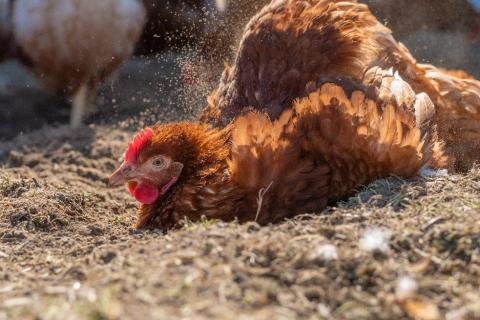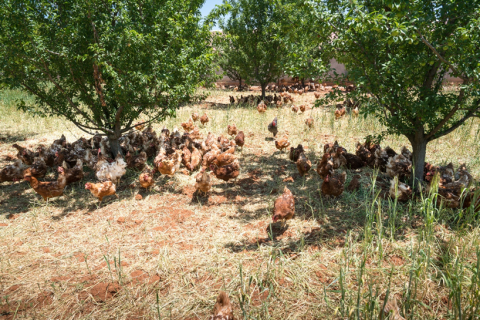3 April 2023
Dr Saba Amir, IBERS, Aberystwyth University.
- Establishment of trees in hen ranges as part of a silvopoultry system is considered to improve poultry welfare, provide wider environmental benefits and increase local biodiversity.
- Because the adoption of this system by farmers is fairly new, more research is needed into some of the challenges faced by farmers like maintaining vegetation and a productive sward under trees.
- The variability in the economic benefits and barriers of this system to farmers suggests that enhanced adoption of silvopoultry will most likely occur with specific initiatives and incentives.
Introduction
Agroforestry or the integration of trees with crops or livestock has been recognised as a sustainable strategy to boost the productivity of the land whilst delivering a range of benefits to the ecosystem and environment compared to agricultural and woodland systems alone. One the other hand is sustainable intensification of livestock which implies balancing productivity of the animal with environmental protection. Silvopoultry are systems where trees are incorporated into the chickens’ range. This multifunctional land use benefits the birds as it has been shown to reduce stress along with the associated environmental benefits from trees. Owing to this there is increasing interest in the integration of trees into free range systems.
Today’s consumers expect that livestock products must
- meet high standards of animal welfare
- be safe and nutritious
- respect the natural environment
Silvopoultry systems offer producers a means of meeting consumer expectations. In return producers benefit from the potential premium price of eggs from farms with at least 20% woodland cover.
Benefits to Poultry
Animal welfare
The red jungle fowl, ancestor of the domestic chicken is native to the dry forests of Southeast Asia and is a ranging and foraging bird. Organic and free-range systems are conducive to expression of natural behaviour linked to the chicken’s ancestry. In these systems the birds, in addition to having access to a hen house, have access to an outdoor run which provides larger space allowances, a higher number and variety of stimuli and the opportunity to
move between locations with different substrates and light intensity. However, studies of typical free range farms have demonstrated that only 10% of the hens make full use of their range with 70% staying within 17m of the hen house. This may be attributed to the fear of predation and lack of shelter from extremes of weather. Well-designed tree planting encourages better use of the range by providing cover, shelter and shade.
In commercial free-range flocks, there is a known relationship between tree cover, range use, and injurious feather plucking, (a behaviour that involves pulling, plucking, and harming feathers of other birds). The higher the percentage of the flock that uses the outdoor range, the lower the prevalence of injurious feather plucking. In addition, use of a greater range decreases the faeces density consequently reducing the parasite load and the risk of infection.
Figure: Dust bathing, a natural behaviour in birds
Deterring carriers of avian influenza
Chickens ranging outside may come into contact with wild birds and their droppings. The avian influenza (AI) virus may spread to the chickens if these wild birds are afflicted with it. While birds of prey are thought to pose a low risk of transmission of the AI virus to poultry, migratory water birds are regarded as the most likely carriers. However, it is not certain if these birds transmit the virus directly to poultry or if intermediate hosts, such as pigeons or rats also play a part. A study investigating the presence of AI risk in birds in and around poultry free-range areas in relation to range vegetation and openness of surrounding landscape revealed that more high-risk birds were observed in free-range areas with less than 5% woody cover, compared to free-range areas with more woody cover. Furthermore, in open landscapes, more high-risk birds were observed in the surroundings of free-range areas than in half-open landscapes. There was no relation found between low-risk birds and woody cover or openness of the landscape.
Benefit to the Producer
Egg Quality
For egg producers, egg seconds and mortality are two important production traits. Egg seconds are eggs with a weak shell and are a significant cost to the farmer. In the UK, second quality eggs are worth 30% of Grade A eggs. Shell quality is affected by several factors such as age, nutrition, stress and health of the hen as well as temperature, day length and light type. Mortality clearly represents a significant economic cost to farmers since birds that die during lay have already consumed significant amounts of feed and other resources and fewer birds implies fewer eggs.
Figure: Grade A eggs (left) vs egg seconds (right)
Analysis of data from 33 free range flocks with tree cover and 33 without tree cover revealed that in flocks with tree cover there were less total egg seconds and significantly less egg seconds post 45 weeks of the production cycle. Bird mortality was also lower in flocks with tree cover. This may be owing to the fact that birds on ranges with tree cover experience less stress than those without tree cover and stress is a significant factor influencing eggshell quality. Tree cover also provides protection from heat.
Benefits to the Environment
In 2016, agriculture accounted for 88% of all UK ammonia emissions, with the largest contributor being livestock. Ammonia is generated from excreted urea or uric acid. Poultry manure contains the highest total N of all livestock species and can potentially convert to ammonia. Long term exposure to high concentrations of ammonia is detrimental to the health of livestock and agricultural workers. It is a respiratory hazard that may result in pneumonia and trigger skin and eye irritations. When released into the atmosphere it dissolves in rainwater and is deposited on land and in waterbodies. Surface runoff from poultry farms can contaminate ground water and lead to deposition of ammonium and phosphorous in water bodies where it causes eutrophication. It is possible to capture ammonia emissions and particulates by planting tree belts downwind from emission sources. Trees can absorb ammonia and help to screen the sources of emissions and protect sensitive habitats such as woodland, rivers, wetlands, or areas of species rich grassland.
Figure: Eutrophication of a water body due to enrichment of water with N and P in surface runoffs
A number of widths of tree belt have been used – the wider the belt the greater the potential capture. Tree belts as narrow as 10m have been shown to reduce ammonia in emissions by around 53% and dust by 56%. However, belts of 15-20m provide a more effective barrier, with layers of shrubs and taller trees. Studies for wider belts suggest ammonia capture of 67%.
Trees protect water bodies surrounding poultry farms by reducing the rainwater runoff containing nutrients and faecal organisms from the farms. Because roots absorb water and nutrients, water infiltration in tree belts is many times greater than the surrounding land and thus enriches the soil microbiome around roots. Tree plantation of ranges and additional planting of other areas on the farm serves as a source of food, water management and carbon sequestration.
Enhancement of Biodiversity
In many parts of the world, including the UK, intensive farming practices have negative effects on local biodiversity. . A remarkable consequence of agroforestry is the increase in biodiversity when compared with farming alone. The presence of shrubs and trees greatly increases the cover for wild birds and mammals. The greater range of plants increases the number of larger insects and the more complex soil increases soil insects and invertebrates. A series of annual wildlife surveys undertaken on 9 woodland egg units in Cumbria from 2016-2019 by the Woodland Trust reveal that “Trees on hen ranges are haven for wildlife”. The survey reported that redshank (Periscaria maculosa) and corn chamomile (Anthemis arvensis), a common feature of many of the unmown areas on the ranges were attractive to butterflies and other invertebrates. In the bird surveys, 59 species of birds were recorded on these ranges, of which 12 are currently included in the Red List of Birds of Conservation Concern including song thrush, tree sparrow and linnet and a further 11 on the Amber list such as meadow pipit and bullfinch. Fourteen species of butterflies were recorded, the majority being common species, but exceptions were the comma butterfly, Polygonia c-album, which normally breeds and hibernates in open woodland and wood edges and the small skipper, Thymelicus sylvestris, whose numbers have been expanding after decades of decline. One hundred and two species of moths were recorded and their numbers were highest in the established ranges compared to the intermediate and new (age of the range) ranges. The surveys observed a correlation between the age of trees and numbers of moths. Bats were recorded on all 9 sites each year. The uninterrupted rows of trees were advantageous to bats as they attracted invertebrates for bats to forage. Overall, the combination of planted trees and structurally diverse ground cover vegetation creates areas of a woodland edge type habitat in the free-range hen ranges and benefits birds, bats and their prey.
Figure: Some species of insects, birds and bats seen during the surveys in Cumbria between 2016-2019. From 12 o’clock, the small skipper butterfly, song thrush, soprano pipistrelle bat, tree sparrow, emerald moth and the comma butterfly
Challenges and barriers for farmers
Despite the numerous benefits of silvopoultry, there are some management challenges farmers face when integrating trees into the range. A farmer workshop with the Sainsbury’s Woodland Chicken Development Group, facilitated by the Organic Research Centre and the Woodland Trust as part of the AGFORWARD project identified that the failure to maintain a viable sward under trees was a crucial issue with silvopoultry systems. Trees compete with the sward for light and water with the added pressure from chickens trampling and close grazing. Moreover, open canopies due to tree thinning favour the growth of unpalatable weeds rather than grasses and maintaining vegetation in open areas to which hens have access is a requirement according to UK/EU legislation. It has been suggested that a sward mixture that can establish quickly, withstand low light levels and competition for water associated
Figure: the challenge of maintaining a viable sward under trees
with trees and the impact of chickens would work well. Results of a trial conducted at a commercial laying hen unit in southern England evaluated 3 sward mixtures and reported that all 3 sward mixtures (1. commercially available grasses and legume seed mix, 2. grasses only seed mix and 3. grasses, legumes and forage herbs seed mix) established well under trees and helped suppress unpalatable weeds. However only the tree block and hence the sward situated 25 m away from the hen house were able to withstand the pressure of chickens due to the uneven ranging behaviour of the chickens. Excluding chickens initially to aid establishment and then optimising chicken pressure appears to be the key to maintaining a sward. This may suit organic production systems where there is a requirement to rest the land for 9 months between chicken populations allowing for the establishment of a sward.
Due to their complexity, all agroforestry systems must be properly planned and managed to maximise any benefits. For example, trees must be spaced wider than the standard woodland creation spacing of 2 x 2 m2 to allow enough sunlight to the understorey. Other drawbacks such as increased labour expenses, complexity of the work and management expenditures, are seen as barriers by farmers to this scheme of production.
Summary
Undoubtedly there are numerous benefits of planting trees on hen ranges as a part of a silvopoultry system including improved hen welfare, disease control, diversification of feed sources, absorption of pollutants from farming activities by trees and increased biodiversity. However, one issue with these systems is the difficulty in maintaining an understorey vegetation which is a requirement for organic and free-range products according to EU/UK regulations. In addition, there are management and socio-economic issues which are the greatest impediments at farmer level. Because of the variability in the economic benefits and challenges of this system to farmers it is likely to be more widely adopted with targeted initiatives and incentives for this type of system.
If you would like a PDF version of the article, please contact
heledd.george@menterabusnes.co.uk



